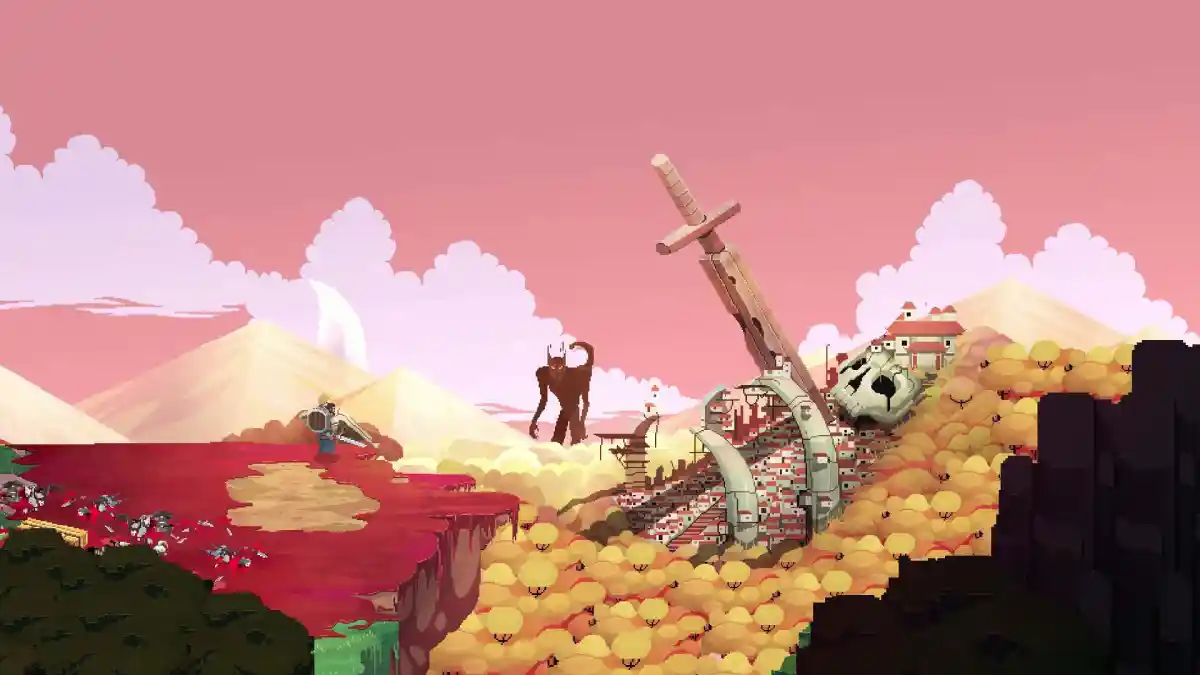Túlio Mendes doesn’t want to say too much about his past. It’s a painful story, filled with family problems — many of which are centered around his absentee father. But the pain isn’t the reason he doesn’t want to share his personal history. He just doesn’t want to give away too much of the story in No Place for Bravery.
“The reason that Jacob is here is to stop me from time to time,” Mendes joked, referring to Jacob Burgess, the director of operations for publisher Ysbryd Games. “I’ve been known to spoil things in the game.”
No Place for Bravery wasn’t always about the pain that can come from family relationships. When developer Glitch Factory first announced the game in 2016, it wasn’t even story-focused. Nor did it have a story, really. Or a main character.
The game, as initially announced, had very little to do with the version that was playable during PAX. It had a familiar aesthetic, with dead titans and giant looming threats in the distance, but it was otherwise pitched as a party-based roguelike featuring a time-rewinding mechanic and, according to its press release, “very few written words.”
“We were trying to remake a game that everyone wanted to make,” said Mendes. “It had no solid direction for itself.”
The game was set to release in 2017, which didn’t happen. The team wasn’t exactly flush with money. Plus, being based in Brazil, there wasn’t much of a game development community to begin with. But as is so often the case, the choice to make a video game was more a labor of love than a sound financial decision, so they found a way to keep the team together even though there was, for the moment, no money in it.

“Developing games in Brazil, it’s kind of hard. It’s hard to pay the bills,” said Matheus Queiroz, Glitch Factory’s executive producer. “We had to focus on work for hire at the time.”
“Here in Brazil, there isn’t a strong market for companies to create games yet,” said Mendes. “What we tried to do with this project — working for hire — we tried to stay together. To not let the team disband. So we needed to make sure that we have just a little bit of money to live and work on this project and create some solid basis to come back to No Place for Bravery.”
They worked for several small local companies and even picked up government work. It wasn’t flashy, but it kept them in business.
“Those would pay the bills for a long time,” said Queiroz. “Also, it taught us how to develop and handle deadlines, and budgets, and stuff like that. Until then, we were just a bunch of colleagues trying to develop our passion — that is, video games.”
But unfortunately, during this period, very little work was being done on the game. The side jobs were taking up everybody’s time and energy. But they always knew they’d get back to working on the project.
“Working on our own IP and putting our identity on this form of art — that is, the video game — it was always our dream,” said Queiroz.
By the end of 2017, Glitch Factory got back together to discuss what direction it was going to go with No Place for Bravery. It was during that meeting that Mendes shared a flash of inspiration he had. And it all came from the widely shared piece of writing advice: “Write what you know.”

“There’s one special moment when I realized I needed to protect this vision,” said Mendes. “In the first meeting, when I decided to talk openly about what Bravery possibly could be from that day on. I started the meeting, and I asked the guys, ‘Who here has problems with his family or his dad?’ At that moment everyone started to cry, so I realized that it’s something that is known deeply in our society.”
From that point forward, the direction of No Place for Bravery changed. They kept the world design and visual style, but gone were the roguelike mechanics, the party system, and the time-shifting. The focus would be on a single character, Thorn, and his quest to find his long-lost daughter alongside his disabled foster son, Phid.
The devs worked to develop an accessible but challenging combat system, which they say has elements of both the slow, methodical combat of the Dark Souls games and the quick, flashy fights found in the Devil May Cry series. The developers feel that they’ve struck a good balance.
“I love how challenging the combat can be,” said Queiroz. “Once you understand the rhythm of the game and the enemies, you kind of go with it. And the feeling that you learned something, it’s amazing. That’s the most fun part of playing video games.”
At the forefront of it all was the tale of an absentee father, whose own past and failings haunt him and follow him through his quest to save his lost daughter.

“I know it’s not my story, but I cried a few times during development, especially during meetings,” said Queiroz. “If we can put into words the feeling — to be poking this sensitive matter throughout the years — It’s tough, man.”
It wasn’t just Mendes’ story, however. Everyone at the studio felt comfortable pulling from their own experiences to flesh out the game’s story and world.
“It’s everybody on the team’s story,” said Burgess. “It’s a really good group, and Túlio taking that first step gave permission to everybody else to be able to put more of themselves into the game and have that connection with the development.”
It’s sharing that connection that has driven the team forward towards completing the game — and it’s a connection that they hope their players will share.
“The message of the game, having a product that has the potential to generate some reflection and thoughts, and maybe change someone — for me, it has been driving me,” said Mendes.






Published: Sep 30, 2020 02:15 pm